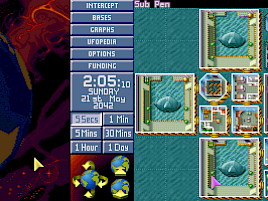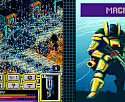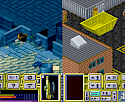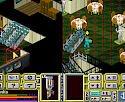X-COM Terror from the Deep Review
Following on from the original UFO: Enemy Unknown, Terror from the Deep (or TFTD for short) is set about thirty to forty years after the previous game. With the alien menace defeated, XCOM's role in the world has slipped to little more then that of a salvage operation: Collecting Elerium (the alien's source of power) from those UFOs sunk to the bottom of the ocean's floor.
Awfully convenient, as that's where the new wave of aliens are coming from. Supposedly awakened by a signal sent by the alien stronghold on Mars (which you destroyed in the first game), these creatures have been living dormant on the ocean floor, waiting for outside contact. Having built up their forces, they're now vying to take over the world in steed of their space-faring brethren.
The game plays like an inverted version of the original. You're presented with a view of the world, but this time around all the action is performed on the seas, as opposed to the land. USOs (Unidentified Submerged Objects) zip about under the waves, are picked up by the sonar systems installed in your bases, and (hopefully) disabled by the torpedoes your own subs are equipped with. The interface is largely unchanged - you still manage research, manufacturing, USO interception and inventory management, using much the same equipment to do so.
Having blasted a USO, a team of "elite aquanauts" are sent in to clean out the bugs inside it. Only in this case the bugs are sea lice, and the term "elite" is used far more loosely. Presumably due to extreme military training cut-backs, your team members are severely lacking in some of the more obvious skills: Swimming, for example. The new game engine seems to have had absolutely no practical features added to take into account that most of the combat takes place underwater, so nearly all units (human or otherwise) run around at the same pace as they would on land, completely unhindered by such things as water pressure and incapable of floating their way over obstacles.
Suspension of disbelief becomes especially difficult when the projectiles start flying - injuries to your soldiers can still be patched up mid-battle by units carrying medical equipment, even if they're to the head. That's right, with a punctured diving helmet, your men can still run around fighting the good fight miles below sea level, without even a penalty to their vision range.
As before, battles are completely turn based, with each action taking "time units" (TUs) to perform. Each unit has a set amount to spend each turn: If, however, you don't use them all up, they can potentially use these points to take pot shots at any aliens they see moving during the enemy's round. It's a good idea to pace your movements and keep behind cover if you have the choice, rather then running out at full speed looking for something to harpoon. While environmental interaction is still minimal, you can at least now open doors without also walking through them, which is a nice addition.
You get to choose exactly what equipment gets brought along to each battle, and which units will carry what. There's not much point in giving the weak rookie the personal torpedo launcher, for example, because his strength stat will penalise his TUs due to the weight. Likewise, if you plan on bombing the enemy with grenades, you can check your team's stats to see who's got the best throwing arm. Performing actions increases competence - with enough practice, a rookie can potentially become a competent sniper, making potshots from across the map.
Despite the technological breakthroughs made in the first game (plus the additional time gap), your starting armaments are somewhat lacking in sophistication. The lasers and plasma weapons are gone, though this is hand-waved in that they wouldn't work underwater, and in any case the Elerium needed to fuel the alien's old guns is in short supply. Why you still aren't given access to these guns during your land battles is not addressed, though any veteran of the first game will soon notice that every weapon in the game is correlated to an older version in UFO:EU. There are only three true "additions", which are just small, medium and heavy versions of the exact same thing (though the weapon in concern, an over-sized power drill, is most gratifying to use).
Conventional weapons mostly consist of dart firing launchers, while the old lasers (which had unlimited ammo) get replaced with gauss technology (using limited clips). These new guns are a notable downgrade in that they do significantly low amounts of damage to various enemies - you can literally empty a dozen rounds into certain aliens (such as the very well armoured Lobstermen) and still not see them go down. The alien's own gear is based on firing sonic pulses, which while powerful, are somewhat limited in firing speed.
One of the main design goals was to make the game more difficult - the previous title had an infamous bug which actually forced you onto the easiest setting after the first mission, causing many players to complain that it was too easy (though this was eventually patched out, patches weren't so easily distributed back before the internet hit today's levels of popularity). As a result, aliens take far more damage then they did before, and also have some boosts to their AI. For example, on spotting one of your units, they might attempt to circle around behind you instead of facing you head on or staying put. Furthermore, some of your more powerful weapons are for "water use only", and when taken up on land become unusable. The new game can be quite a challenge.
The main area of improvement would be in terms of terrain. The amount of different map types has been more then doubled, the maps themselves are larger, and two-stage missions more frequent. For example, every alien base you invade requires you to first punch your way through their surface defenses, then actually trash the base itself from the inside. The general amount of artwork per map has also been expanded, though unfortunately the coders decided to make two (mostly featureless) zones appear far more often then any of the others, making combat feel very "samey" in short order. It gets worse in that, while beautiful and exciting the first few times, the repeated, massive cruise ship missions are not randomly generated like the other maps and take a very long time to complete. Huge penalties are in store if you opt to skip them, of course. Fortunately there's still fun to be had exploring sunken ships, ruins from civilisations long lost, and secret underwater research facilities, but such impressive sights are sadly infrequent and you'll mostly find yourself looking at sand, coral and rocks.
Sadly, the game does little to address the flaws of the original. It uses a slightly modified version of the same game engine, inheriting most of the bugs and introducing some new ones in the process. Most of the more notable ones are in the research section of the game (which is the closest thing it has to a "plot" - each breakthrough your scientists make brings you closer to understanding what's going on, and how to stop the alien's master plan). Certain research items now require you to capture certain aliens in order to unlock progression, but some of these creatures become very rare indeed later in the campaign, or worse yet, glitch the technology tree if you research them too early. Because of this, it can be quite easy to lock yourself into a "no-win" scenario, and it'll certainly take you much longer to get to work your way through to the end.
TFTD is a title that offers more of a challenge then it's predecessor, but unfortunately relies on the previous game for most of it's strengths. Luckily, the game breaking bugs have been addressed by BladeFireLight's update of XcomUtil, though it would certainly be nice not to have to worry about such things at all. The game itself is currently available at GamersGate (along with most of the rest of the series), and can also be discussed in our own forums.





